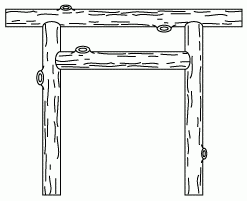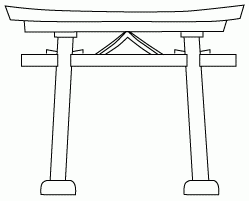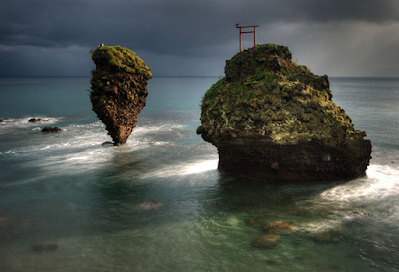A torii (torii gate) is a traditional Japanese gate most commonly found at the entrance of or within a Shinto shrine, where it symbolically marks the transition from the mundane to the sacred. The presence of a torii at the entrance is usually the simplest way to identify Shinto shrines, and a small torii icon represents them on Japanese road maps.
The first appearance of torii gates in Japan can be reliably pinpointed to at least the mid-Heian period; they are mentioned in a text written in 922. The oldest existing stone torii was built in the 12th century and belongs to a Hachiman shrine in Yamagata Prefecture. The oldest existing wooden torii is a ryōbu torii (see description below) at Kubō Hachiman Shrine in Yamanashi Prefecture built in 1535.
Torii gates were traditionally made from wood or stone, but today they can be also made of reinforced concrete, copper, stainless steel or other materials. They are usually either unpainted or painted vermilion with a black upper lintel. Shrines of Inari, the kami of fertility and industry, typically have many torii because those who have been successful in business often donate torii in gratitude. Fushimi Inari-taisha in Kyoto has thousands of such torii, each bearing the donor's name.
 |
| The famous torii at Itsukushima Shrine |
Uses
The function of a torii is to mark the entrance to a sacred space. For this reason, the road leading to a Shinto shrine (sandō) is almost always straddled by one or more torii, which are therefore the easiest way to distinguish a shrine from a Buddhist temple. If the sandō passes under multiple torii, the outer of them is called ichi no torii. The following ones, closer to the shrine, are usually called, in order, ni no torii and san no torii. Other torii can be found farther into the shrine to represent increasing levels of holiness as one nears the inner sanctuary (honden), core of the shrine. Also, because of the strong relationship between Shinto shrines and the Japanese Imperial family, a torii stands also in front of the tomb of each Emperor.
In the past torii must have been used also at the entrance of Buddhist temples. Even today, as prominent a temple as Osaka's Shitennō-ji, founded in 593 by Shōtoku Taishi and the oldest state-built Buddhist temple in the country (and world), has a torii straddling one of its entrances. (The original wooden torii burned in 1294 and was then replaced by one in stone). Many Buddhist temples include one or more Shinto shrines dedicated to their tutelary kami ("Chinjusha"), and in that case a torii marks the shrine's entrance.
Benzaiten is a syncretic goddess derived from the Indian divinity Sarasvati, who unites elements of both Shinto and Buddhism. For this reason halls dedicated to her can be found at both temples and shrines, and in either case in front of the hall stands a torii. The goddess herself is sometimes portrayed with a torii on her head. Finally, until the Meiji period (1868-1912) torii were routinely adorned with plaques carrying Buddhist sutras.
Yamabushi, Japanese mountain ascetic hermits with a long tradition as mighty warriors endowed with supernatural powers, sometimes use as their symbol a torii. The torii is also sometimes used as a symbol of Japan in non-religious contexts. For example, it is the symbol of the Marine Corps Security Force Regiment and the 187th Infantry Regiment, 101st Airborne Division and of other US forces in Japan. It is also used as a fixture at the entrance of some Japantown communities, such as Liberdade in São Paulo.
Origins
The origins of the torii are unknown and there are several different theories on the subject, none of which has gained universal acceptance. Because the use of symbolic gates is widespread in Asia-such structures can be found for example in India, China, Thailand, Korea, and within Nicobarese and Shompen villages-many historians believe they may be an imported tradition.
 |
| Red torii gate of Wat Khao Sung Chaem Fa temple on Khao Sam Sip Hap mountain, Thailand |
They may, for example, have originated in India from the torana gates in the monastery of Sanchi in central India. According to this theory, the torana was adopted by Shingon Buddhism founder Kūkai, who used it to demarcate the sacred space used for the homa ceremony. The hypothesis arose in the 19th and 20th centuries due to similarities in structure and name between the two gates. Linguistic and historical objections have now emerged, but no conclusion has yet been reached.
 |
| Sanchi India |
In Bangkok, Thailand, a Brahmin structure called Sao Ching Cha strongly resembles a torii. Functionally, however, it is very different as it is used as a swing. During ceremonies Brahmins swing, trying to grab a bag of coins placed on one of the pillars.
 |
| Sao Ching Cha, Thailand |
Other theories claim torii may be related to the pailou of China. These structures however can assume a great variety of forms, only some of which actually somewhat resemble a torii. The same goes for Korea's "hongsal-mun". Unlike its Chinese counterpart, the hongsal-mun does not vary greatly in design and is always painted red, with "arrowsticks" located on the top of the structure (hence the name).
 |
| Hongsamun, Korea |
Various tentative etymologies of the word torii exist. According to one of them, the name derives from the term tōri-iru.
 |
| A Chinese pailou |
Another hypothesis takes the name literally: the gate would originally have been some kind of bird perch. This is based on the religious use of bird perches in Asia, such as the Korean sotdae, which are poles with one or more wooden birds resting on their top. Commonly found in groups at the entrance of villages together with totem poles called jangseung, they are talismans which ward off evil spirits and bring the villagers good luck. "Bird perches" similar in form and function to the sotdae exist also in other shamanistic cultures in China, Mongolia and Siberia. Although they do not look like torii and serve a different function, these "bird perches" show how birds in several Asian cultures are believed to have magic or spiritual properties, and may therefore help explain the enigmatic literal meaning of the torii's name ("bird perch").
 |
| Torii or traditional Japanese gate. Heian-jingū. Sakyō-ku, Kyoto. |
Poles believed to have supported wooden bird figures very similar to the sotdae have been found together with wooden birds, and are believed by some historians to have somehow evolved into today's torii. Intriguingly, in both Korea and Japan single poles represent deities (kami in the case of Japan) and hashira is the counter for kami.
 |
| A Korean Hongsalmun |
In Japan birds have also long had a connection with the dead, this may mean it was born in connection with some prehistorical funerary rite. Ancient Japanese texts like the Kojiki and the Nihon Shoki for example mention how Yamato Takeru after his death became a white bird and in that form chose a place for his own burial. For this reason, his mausoleum was then called shiratori misasagi white bird grave). Many later texts also show some relationship between dead souls and white birds, a link common also in other cultures, shamanic like the Japanese. Bird motifs from the Yayoi and Kofun periods associating birds with the dead have also been found in several archeological sites. This relationship between birds and death would also explain why, in spite of their name, no visible trace of birds remains in today's torii: birds were symbols of death, which in Shinto brings defilement (kegare).
 |
| Beachside torii on the island of Naoshima. |
Finally, the possibility that torii are a Japanese invention cannot be discounted. The first torii could have evolved already with their present function through the following sequence of events :
- Four posts were placed at the corners of a sacred area and connected with a rope, thus dividing sacred and mundane.
- Two taller posts were then placed at the center of the most auspicious direction, to let the priest in.
- A rope was tied from one post to the other to mark the border between the outside and the inside, the sacred and the mundane. This hypothetical stage corresponds to a type of torii in actual use, the so-called shime-torii, an example of which can be seen in front of Ōmiwa Shrine's haiden in Nara (see also the photo in the gallery).
- The rope was replaced by a lintel.
- Because the gate was structurally weak, it was reinforced with a tie-beam, and what is today called shinmei torii or futabashira torii (two pillar torii) (see illustration at right) was born. This theory however does nothing to explain how the gates got their name.
The shinmei torii, whose structure agrees with the historians' reconstruction, consists of just four unbarked and unpainted logs: two vertical pillars (hashira) topped by a horizontal lintel (kasagi) and kept together by a tie-beam (nuki). The pillars may have a slight inward inclination called uchikorobi or just korobi. Its parts are always straight.
 |
| Torii parts and ornamentations |
Parts and ornamentations
- Torii may be unpainted or painted vermilion and black. The color black is limited to the kasagi and the nemaki. Very rarely torii can be found also in other colors. Kamakura's Kamakura-gū for example has a white and red one.
- The kasagi may be reinforced underneath by a second horizontal lintel called shimaki or shimagi.
- Kasagi and the shimaki may have an upward curve called sorimashi.
- The nuki is often held in place by wedges (kusabi). The kusabi in many cases are purely ornamental.
- At the center of the nuki there may be a supporting strut called gakuzuka, sometimes covered by a tablet carrying the name of the shrine (see photo in the gallery).
- The pillars often rest on a white stone ring called kamebara (turtle belly) or daiishi (base stone). The stone is sometimes replaced by a decorative black sleeve called nemaki (root sleeve).
- At the top of the pillars there may be a decorative ring called daiwa (architrave).
- The gate has a purely symbolic function and therefore there usually are no doors or board fences, but exceptions exist, as for example in the case of Ōmiwa Shrine's triple-arched torii (miwa torii, see below).
 |
| Ōmiwa Shrine |
Styles
Structurally, the simplest is the shime torii or chūren torii (see illustration below). Probably one of the oldest types of torii, it consists of two posts with a sacred rope called shimenawa tied between them. Shimenawa are lengths of laid rice straw or hemp rope used for ritual purification in the Shinto religion. All other torii can be divided in two families, the shinmei family and the myōjin family. Torii of the first have only straight parts, the second have both straight and curved parts.
 |
| Shimenawa |
Shinmei family
The shinmei torii and its variants are characterized by straight upper lintels.
 |
| Itsukushima ShrineIn Kyoto Gyoen, Kamigyo Ward, Kyoto City |
 |
| Nune tori at Inariyama kadasya |
 |
| Nemaki torii gate at Ujigami Shrine, Uji City, Kyoto Prefecture |
Torii Design Standards
1. Torii Gate Structure (reference) :
- A typical Torii gate has the following main components:
- Kasagi is the top end of the gate which is usually painted black
- Shimaki is the main brace placed under the kasagi
- Nuki is a reinforcing brace between 2 columns to ensure the stability of the gate
- Kusabi is Nuki fixed wedge and column
- Gakuzuka is the middle strut between Nuki and supporting Shimaki
- Daiwa is the top of the column
- Hashira is the main bearing column
- Kamebara is the pillar stone
- Nemaki is a black painted cylinder that functions like a Kamebara
- Kasagi and Shimaki forming a curve is called Sorimashi
- After determining the clear width and height of the gate, we can rely on the following formulas to complete a Torii gate drawing :
- With proposed size ratio for Torii :
- A torii is a traditional Japanese gate, which marks the boundary between the sacred and mundane. Torii Gates are gnerally regarded as a symbol of Shinto shrines, and different styles and choice of materials can be found throughout Japan.
- Myojin torii is more ornamental form of torii gate, characterized by the double lintels with curvature. In general, two columns have inward inclination, and lintels and tie beam are connected by a supporting strut called gakuzuka.

- Shinmei torii is the simpler form of torii gate, characterized by the single straight lintel. In general, all elements are round in section and meet at right angles.
- Oyunohara o-torii in Wakayama prefecture is the biggest torii in Japan and 33.9m tall and 42m wide.Meiji jingu daini torii in Tokyo is one of the biggest wooden made torii, and it is 12m tall and 17.1m wide.
- This gate is located on a strange rock, named after the two gods Ebisu sama and Daikoku sama. 2 lucky gods out of 7 famous gods in Japan, believed by people to help business prosper.
- The Benzaiten Shrine here is famous for its legend of man-eating sharks. Even so, this place is still a very beautiful place to watch the sunset and sunrise.
- Hakone Shrine, founded in 757, is a sacred place for alpine worship. During the Kamakura shogunate, this place was revered by many important figures. Here, there is a wooden statue that is worshiped as a god of good luck and helping to exorcise evil. Inside the temple there is also a row of cedar trees over 800 years old, the atmosphere is very sacred. The Torri Gate is located on the water of Lake Ashi.
- A Torri gate is located at the tip of the rocky area where the waves of the Oarai coast hit hard. This place is also one of the famous sunrise spots in Japan. Since the coast is on the east side, you can see the beautiful sunrise through the Torri gate.
- This is the largest Torri gate in Japan, 18.5m high from the river bottom and 22.5m wide. Since ancient times, Ichino Torri has been an important gateway in waterway trade.
- The Torri Gate here is located right on the cliff facing the sea. Behind is the temple, in front is the sea, so many people who come here after visiting the temple will go to the Torri gate to enjoy the sea view.
- This place is famous as a fishing spot in the fall. People often come here to take pictures with the striking red Torri gate. When the weather is nice, the scenery here is very peaceful.
- On the way to Ise Bay, you will see a lonely Torri gate in the middle of the sea, next to a stone that is up to 200 million years old.
- Inasa was voted as one of the 100 most beautiful beaches in Japan. There are many mythological stories handed down here. Unlike the red Torri gates in many other places, the Torri gate here is silver, located on a cliff by the sea and behind there is a temple.

- It can be said that this is the place with the most Torri gates, about 123 connected to form an impressive winding arc. If you look closely at the Torii gate at the exit of the road behind the mountain, you will see a money box. It is said that wishes will come true if you contribute to them.



































































No comments:
Post a Comment